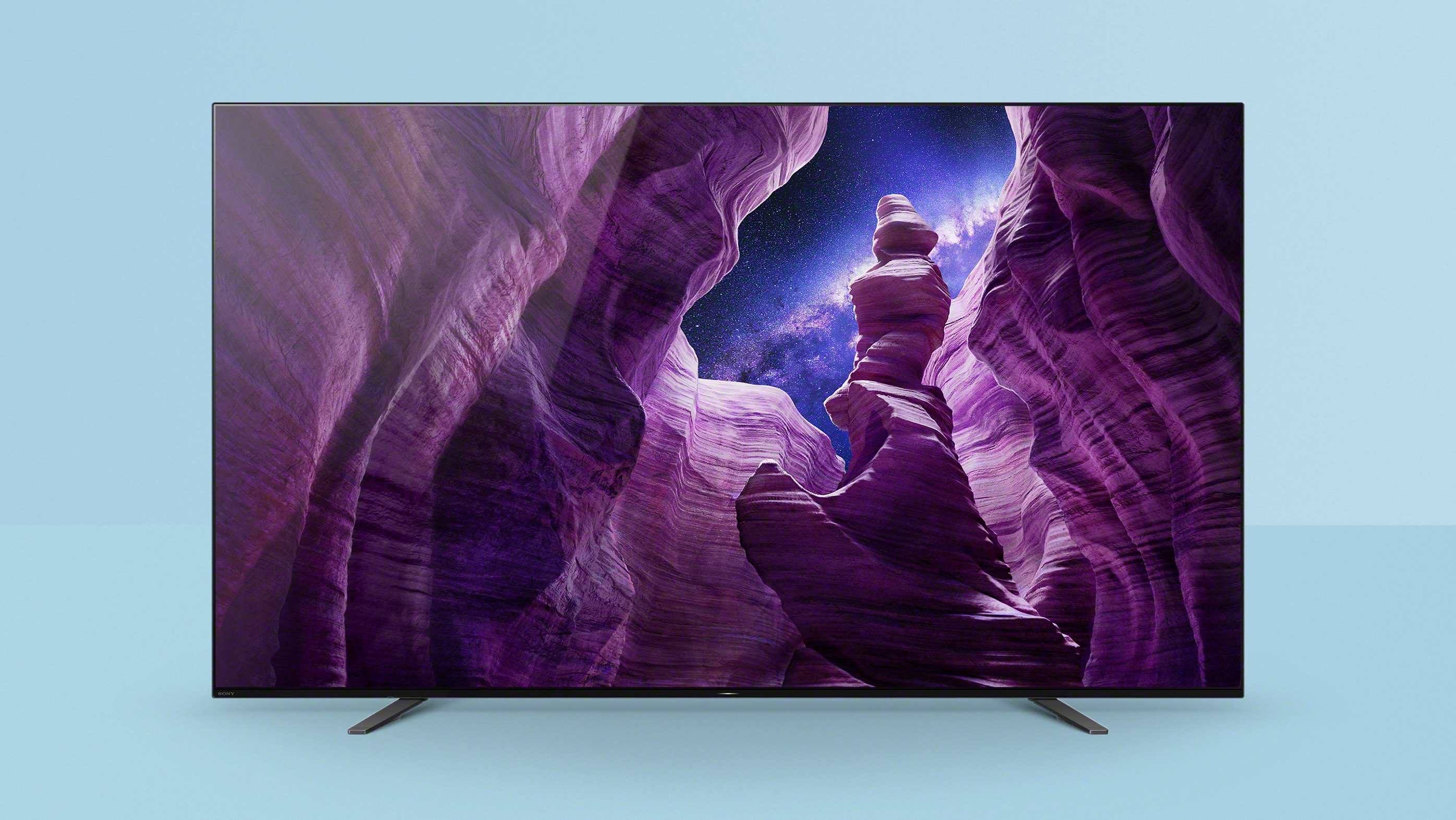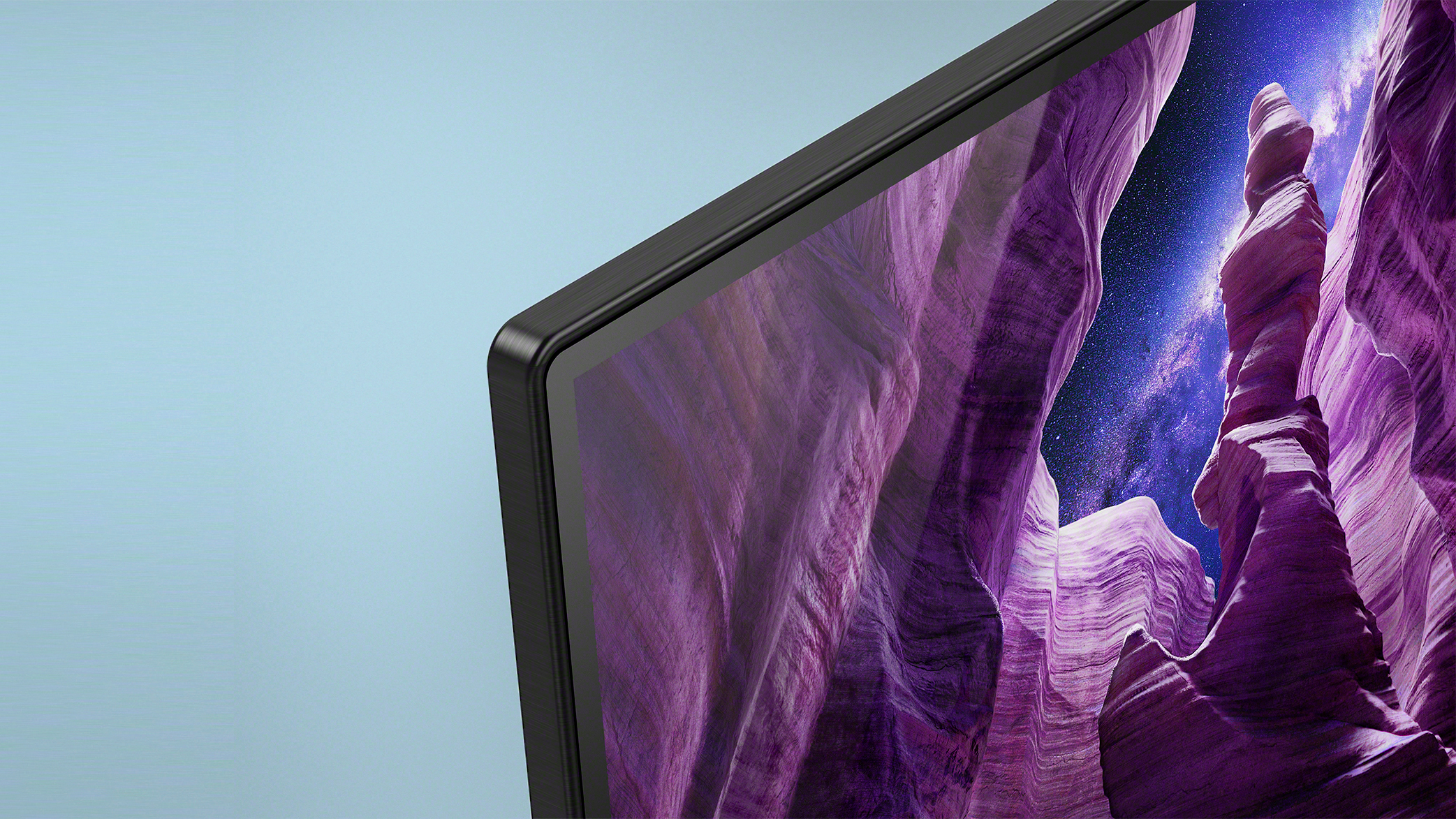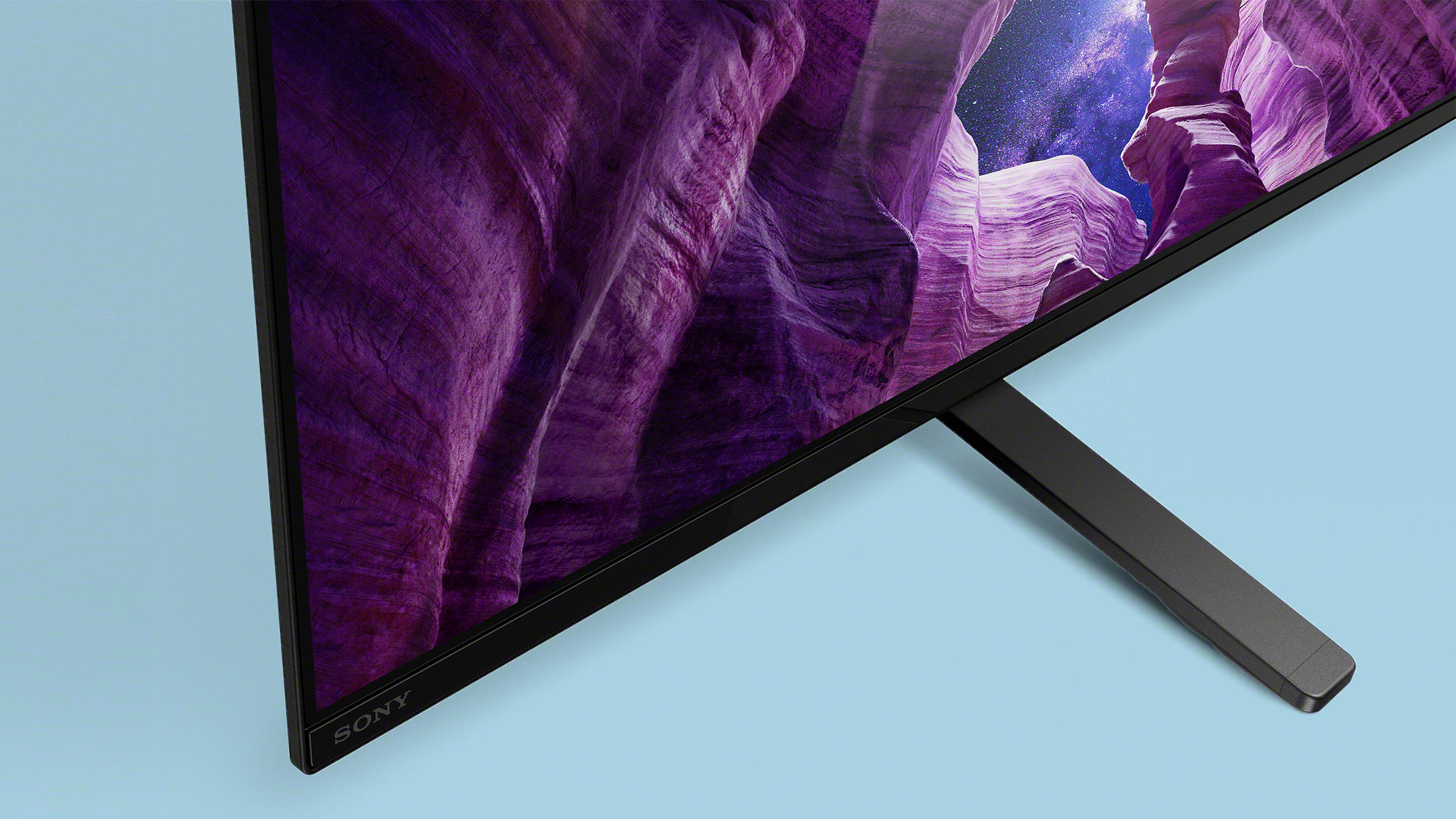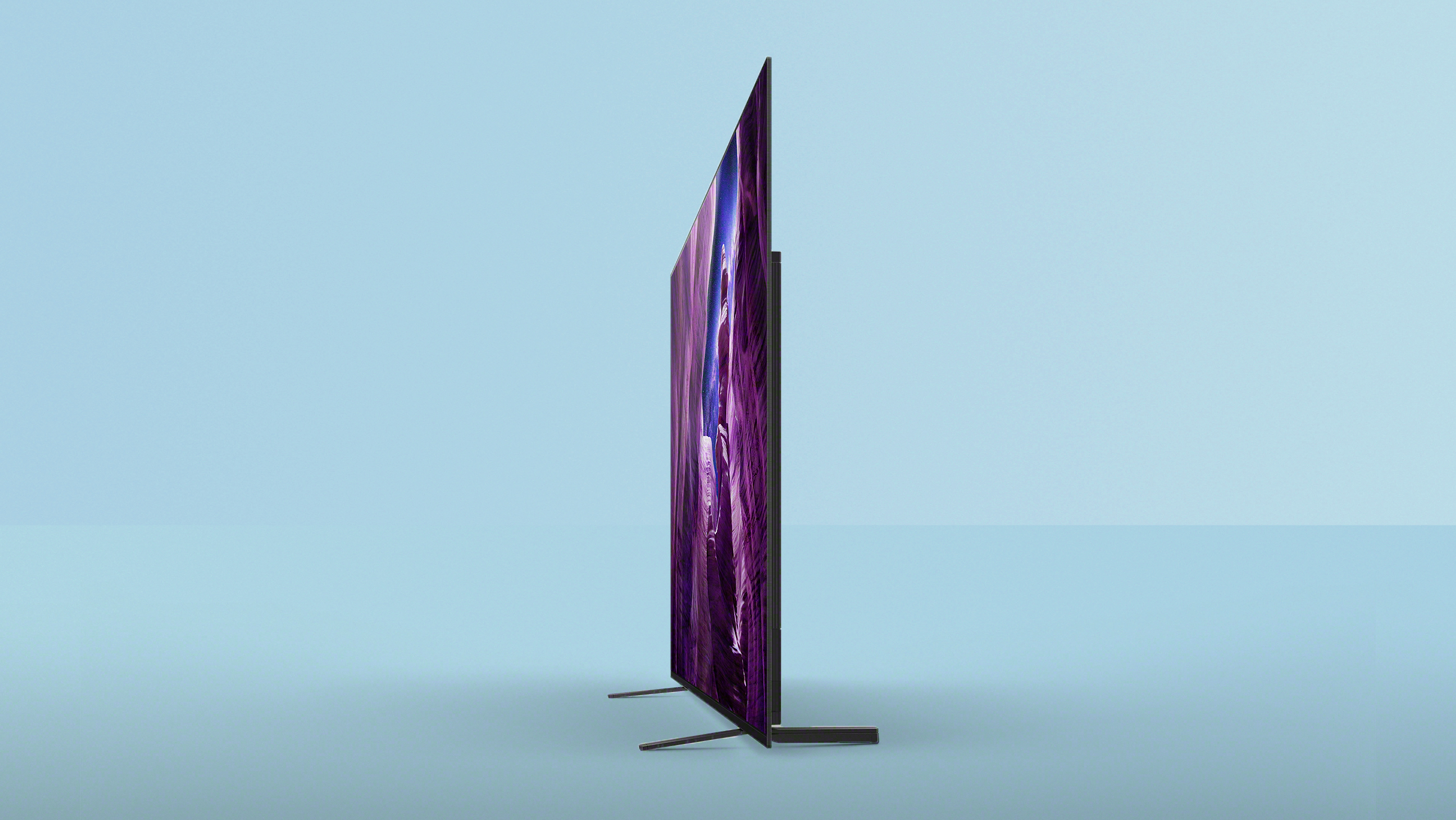Sony A8/A8H review (KD-65A8): impeccable OLED TV pictures and great built-in sound
The Sony A8/A8H OLED TV matches fantastic image processing with ingenious speaker tech


The Sony A8 is nothing short of a tour de force for enthusiasts who value the finer things in AV life: local contrast, refined colours, shadow detailing, subtle but effective motion management and more… and it has sound you don't have to instantly replace.
-
+
Beautifully refined, natural pictures
-
+
Imposing, monolithic design
-
+
Good sound quality
-
-
Perhaps not bright enough for very light rooms
-
-
No HDR10+ support
-
-
Limited gaming features
Why you can trust T3

In this Sony A8/A8H review, we're looking at the cheapest OLED TV from Sony's 2020 TV range, though it certainly isn't cheap in the sense of cutting corners – we're not sure Sony's TV division would know how to do that if it wanted to. It's one of the best OLED TVs available right now, as well as unquestionably one of the best TVs overall, and remains so even in 2021 – its replacement, the Sony A90J is arriving now, but that means the Sony A8/A8H has had some major price cuts since its launch.
The reason we're referring to both the Sony A8 and A8H is that it's called different things in different locations – it's the A8 in the UK, and the A8H in the US and Australia.
With LG already setting the bar pretty high when it comes to OLED TVs with LG CX from 2020, and the brand new LG C1, the Sony A8/A8H has hot competition. Thankfully though, its unique Sony processing and Acoustic Surface Audio system made it both good enough and different enough to more than make its mark in the cut-throat world of the best 55-inch TVs and best 65-inch TVs.
Being an OLED TV, its pixels make their own light, rather than the LCD/QLED system of using a bright backlight behind the pixels to provide the actual light. This means they can control their brightness individually, giving you sharp contrasts between light and dark just like the real world, with no light spilling out into the black, which is a standard feature of backlit TVs.
• OLED vs QLED: the technologies explained, and which is best for you?
Of course, there are a couple of downsides, but they're more to do with preference rather than being problems with the TV itself – we'll take you through those in this Sony A8/A8H review, and explain why we love its images so much. We took a look at the 65-inch version for our review.

Sony A8 review: price, release date and features
The A8 was Sony’s entry-level OLED TV for 2020, known as the A8H in the US, and was released in May 2020.
Get all the latest news, reviews, deals and buying guides on gorgeous tech, home and active products from the T3 experts
There are two sizes: The 55-inch Sony KD-55A8 launched at £1,799/Sony XBR-55A8H was $1,899; the 65-inch Sony KD-65A8 was £2,799/Sony XBR-65A8H was $2,799. However, prices have come way down from launch, making the A8 competitive with more mid-range models, though it still remains fairly high-end overall. You can find the latest prices below.
These prices sensibly put these models on a par with the LG CX equivalent sizes, and if you're looking at buying an OLED TV, you should definitely take a look at our LG CX review, because it's the primary competitor to this Sony.
The A8 is powered by the X1 Ultimate processor, which has all kinds of tricks up its sleeve. For starters, it uses a huge dual database of learned image attributes to identify the sort of source you’re watching and apply the best picture settings accordingly. This is particularly important when it comes to upscaling sub-4K sources to the screen’s native 4K resolution.
It also deploys a Super Bit Mapping system for removing colour stripes from HDR sources, and X-Motion Clarity technology (available through a ‘Clearness’ setting) which can inject partial black frames into the image feed to deliver a cinematic look to motion without compromising brightness as much as normal black frame insertion techniques do. This accompanies Sony’s more typical but always impressive MotionFlow frame interpolation technology.
Sony is so confident about X1 Ultimate’s ability to convert standard dynamic range sources to high dynamic range, meanwhile, that it applies the processing by default, without giving you the option to turn it off, to the TV’s Vivid, Standard and Cinema picture presets.
There’s also a so-called Pixel Contrast Booster that increases the brightness of intense picture elements across the colour spectrum to deliver a more ‘luminous’, contrast rich picture. Finally, X1 Ultimate works with Sony’s Triluminos technology to enhance colour refinement and range.
The A8’s smart features are built on the Android 9.0 platform. This provides access to plenty of the all-important video streaming platforms – Disney+, Netflix, Amazon Prime Video, Rakuten, YouTube and so on. The only notable omission at the moment is the Apple TV app.
Also, since Android continues to have a blind spot when it comes to some of the UK’s catch-up services, Sony has added YouView to the A8’s smart offering. This brings together all the main catch up services and presents them in a handy electronic programme guide format.
The A8 supports the Dolby Vision and HLG HDR formats on top of the industry standard HDR10 system. It does not, though, support the HDR10+ format that’s appeared as an alternative to Dolby Vision.
While HDR10+ content is much rarer than Dolby Vision content, there are a few 4K Blu-rays that provide it, and it’s available with all of Amazon Prime Video’s HDR content. So even though Sony argues it can deliver comparable results to HDR10+ using its own processing, it would be nice to see Sony joining Panasonic and Philips in adding HDR10+ to its TVs’ HDR support in future years.
The 65A8 has been awarded official IMAX Enhanced certification, though. Meaning its picture quality has formally been approved as capable of doing justice to the extra picture quality IMAX claims is available from content mastered using its own proprietary techniques. IMAX Enhanced content is limited to a few Sony 4K Blu-rays and Rakuten streams in the UK, but it does usually deliver impressive results.
The A8 also sports a Netflix Calibrated mode that activates a picture set up which resembles as closely as possible the look Netflix uses when mastering Netflix Original content, so you're seeing that stuff with the full artistic intention.
There’s no support, though, for the new Filmmaker Mode or Dolby Vision IQ options starting to appear on some TVs. The former, created in conjunction with the filmmaking community, essentially turns off most of a TV’s processing features to deliver a more ‘authentic’ picture. The latter adds room light compensation to the way Dolby Vision pictures are presented. However, I’m not entirely convinced the former is necessary, and Sony provides its own new intelligent Ambient Optimisation feature for helping images retain their impact in bright rooms.
The A8’s connections include four HDMIs and three USBs. None of the HDMIs, though, support the 40Gbps or more data rates you need to enjoy the 4K/120fps HDR images we’re expecting to see from the PlayStation 5 and Xbox Series X. Nor is there any support for Variable Refresh Rates, or the automatic low latency mode feature, whereby the TV could be told by the console when it’s receiving a game source and adjust the its picture setup accordingly. For those looking forward to the next generation, these omissions alone make the LG CX the better choice, because it supports them all – that's why it's our pick as the best TV for gaming.
The only advanced feature the 65A8’s HDMIs support is eARC technology, which lets the TV pass uncompressed high-performance audio – including Dolby Atmos – out via its HDMI port to suitably equipped soundbars and AV receivers.
We can finish this round up of the A8’s features with a couple more audio goodies. First, it creates its sound by using an actuator to vibrate its own screen. This helps it deliver a large, forward-projecting sound that can also track the location in a picture where specific sounds are supposed to be coming from.
Second, the set carries Dolby Atmos decoding. Though with only a 2.2 speaker configuration to play with (two main speakers and two subwoofers), any Atmos-related height, side or rear channel effects the set may deliver will have to be provided by virtual sound channel processing rather than actual directional sound.

Sony A8 review: image quality
Right from the off, the A8/A8H’s pictures ooze class. Dark scenes, for starters appear nothing short of immaculate. OLED’s ability to deliver deep pure black colours (because, unlike LCD, each pixel makes its own light) is fully exploited, leaving no hint of grey to hang over even the darkest of dark corners.
The black level performance is supremely consistent, too. In terms both of its evenness across the screen (with real-world content, at least) and immunity from the occasional shift into grey that crept into one or two shots on the LG CX or LG GX models.
Best of all, though, the A8 does a fantastic job of coping with ‘near black’ content. Subtle shadow details appear plentiful and natural, avoiding the hollow look you get with screens that can’t hold on to subtle greyscale and dark colour tones. There’s also hardly any of the speckling, fizzing, blocking or flashing noise in dark areas that have plagued some OLED TVs over the years.
The impact of having this much refinement at the ‘business end’ of OLED picture performance can’t be overstated, especially if you’re the sort of person who likes to watch films in dark rooms. That’s not to say, though, that the A8 doesn’t also care about HDR’s extra dynamism and punch. The extended light range created by Sony’s pixel booster technology combines with the exceptional depth and control of its black levels to deliver some spectacularly intense images with HDR sources.
Just as importantly, the A8 controls the brightness available to it so well that it paints a palette of colours and shades between its dark and light extremes that makes its pictures look like they’re working with more brightness than they actually are.
I say this because the A8 isn’t, objectively, especially bright. On a white HDR box that fills 10% of the screen area I only measured a peak light output of 640 nits. That’s a fair bit lower than the sort of numbers we’re used to seeing now with rival OLED brands, including LG.
But Sony’s processing is now so astute and effective at controlling the way light is used that its HDR pictures don’t now (unlike those of previous Sony OLED generations) typically look substantially duller than those of rival OLED TVs.
Given that light and black level control play such a big part in a TV’s colour performance, it’s no surprise to find that the A8 is also a gorgeous colour performer. Tones look rich, exceptionally subtle in tone and shade, but also consistently extremely natural. Even if you use the set on a relatively aggressive picture preset, the enhanced saturations still retain an authentic ‘core’ and balance.
The A8’s finesse with colour, light and shading contributes, too, to a beautifully detailed and textured picture that gets excellent value from the screen’s native 4K resolution. There are, to be clear, sharper-looking 4K TVs out there. Samsung and Philips in particular tend to excel in that area. But the A8’s detail feels natural and a net result of all many different picture quality elements coming together, rather than just the outcome of heavy sharpness or detail boosting processing.
The ultra-refined feel to the A8’s colours is helped, too, by Sony’s Bitmapping processing. This does a good job of removing pretty much all striping from tricky HDR content such as dusk skies or swirling mist.
The clarity remains impressively unaffected by motion in the frame, too. So long as you stick to one of its tamer settings, the MotionFlow processing does a typically excellent job of reducing judder without causing unwanted side effects or making proceedings look unnaturally fluid. The new X-Motion Clarity option can be quite effective too, so long as you avoid the over-aggressive Max Clearness setting.
The A8 is every bit as refined with sub-4K SDR content as it is with 4K HDR. Upscaled pictures look dense and authentic, again with an emphasis on naturalism rather than excessive sharpness. And Sony’s SDR to HDR conversion is for me the best in the business, gently expanding the original content’s colour and light range without losing the image’s balance or moving too far from the original tones.
Trying to find fault with the A8’s pictures, its approach to HDR means that while it delivers HDR typically with more punch than you might expect of a 640-nit screen, some of the very brightest HDR elements can lose a little subtle shading detail. Also, the screen’s a bit reflective, which combines with its limited brightness to mean it's not the best option for bright rooms with direct sunlight.
LG's OLEDs can go brighter and so are a little better for this, but LCD TVs remain the brightness kinds, and so the Samsung Q80T or Samsung Q90T are the 4K TVs to beat for rich HDR even when there's a lot of ambient light.
The incredibly quality of the picture also makes it feel all the more unfortunate that the set can’t deal with the sort of higher 4K frame rates we’re hoping to see from the upcoming consoles, since that combination really could have produced just astoundingly realistic images.
While the latter point may make gamers pause for thought, though, the Sony A8’s picture quality remains, overall, an AV enthusiast’s dream.

Sony A8 review: sound quality
The A8’s innovative audio solution of using the screen itself as the main speakers works very well. It helps the sound push forwards into the room, for starters, giving it more attack and immediacy. It also gives the sound a wide, open quality you don’t typically hear with regular TV speakers.
The soundstage spreads a good distance to left and right as well as forward, and placement effects are positioned with impressive accuracy within that audio space. Vocals always remain clear and locked to the screen, and even at high volumes there’s no significant harshness or distortion.
The tweaks Sony has made for the latest version of its Acoustic Surface technology inject slightly more bass than previous entry level OLED models have provided, too.
The sound can be a touch polite with really brutal soundtrack moments, height effects in Dolby Atmos mixes have limited impact, and there are TVs out there that push bass deeper. But few TVs sound more as consistently satisfying and involving.

Sony A8 review: design & usability
Because it doesn’t need to find space for conventional speakers, the A8 can present a very minimalist face to the world. The metal-edged frame round the screen is super-slim, and in its ‘conventional’ design it sits so low on its desktop feet that you barely notice them. You can, though, adjust the feet so that they lift the screen a couple of inches, giving you space to add a soundbar if you do go down that route.
Build quality for the trim outer edges of the A8 is excellent, too. The central part of the rear is chunky by OLED standards, but from all but the most severe angles the set presents an impressively monolithic face to the world.
The A8’s dependence on Android TV for most of its smart features doesn’t make it the easiest TV to use. The full-screen approach of Android’s home screen means you can’t browse content while still watching TV, and the interface feels cluttered. You can customise things a bit these days, but Android still feels less interested in adapting to different users’ needs than most rival smart platforms.
Sony’s 2020 remote control, though, is much better than its 2019 predecessors, and the built-in support for both Google Chromecast and Google Assistant voice recognition are helpful, too.

Sony A8 review: verdict
The A8/A8H sees Sony’s OLED story really come of age. Sony’s unique Acoustic Surface technology continues to deliver impressive sonics, and while there might perhaps still be room for improvement on the brightness front, the way the A8 harnesses Sony’s processing quality to OLED’s self-illuminating charms results in pictures that often take your breath away.
Where it has downsides, they're situational rather than fundamental flaws: some people will want a brighter TV to fight through sunlight better, some will want full support for the gaming features of the PS5 and next Xbox, and some may want a slicker smart TV system with Apple TV support.
But if none of those sound like they'd be a problem, then the Sony A8 is simply brilliant, especially as the lower price you can now find it for.
Sony A8 review: also consider
The big competition is the LG CX OLED 4K TV, which is available in the same 55-inch and 65-inch sizes as the A8/A8H, but also comes in a smaller 48-inch size (the first OLED at this size) and a jumbo 77-inch model. It's brighter than the Sony A8, it has every fancy gaming and connection feature going, and it has a nicer smart TV setup. However, while the LG CX offers truly fantastic image quality, the Sony has just an extra deft touch for movies in ideal dim conditions.
If the price feels too high, you should also consider the still-on-sale LG C9, though, which is last year's version of the CX. The main difference from this year's model is its processing, which is still really strong – the actual OLED panel is just as good, and it still has all those great gaming features and the smart TV system. But now, it's an extremely low price compared to this year's OLEDs. Read our full LG C9 review for all the details.
The Samsung Q90T is the QLED TV closest to the Sony A8 in price currently (it was notably more expensive, but had its price cut quickly after launch), and it offers a big boost in brightness over the A8, along with the huge HDR punch that QLED is known for. It uses localised dimming of its backlight to challenge OLED for deep black control, though OLED is still superior and more precise ultimately, even if the gap is narrow now. Samsung's smart TV system is great, as is its processing (though the Sony is marginally better on that front). If you want a bright LCD alternative to the A8, this is the TV to get.
The Samsung Q80T is the model down from that, and is again a strong option for those who'd like to spend a little less. It's a little less bright than the Q90T (though still brighter than the A8), with less precision in its localised dimming of the backlight, but for its new reduced price, it's an astounding visual performer for the money (and, again, is more gaming-friendly).
John Archer has been testing TVs and AV gear for over 25 years, having worked on Home Cinema Choice magazine. He's a contributor to Forbes, TechRadar, Trusted Reviews, Wired and many more places – if you've owned a TV in the last couple of decades, John's probably reviewed it somewhere. He's seen so many hot new technologies come and go, like tears in the rain.
